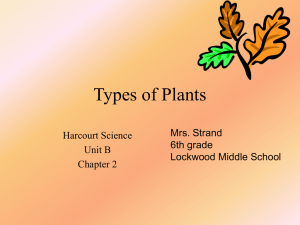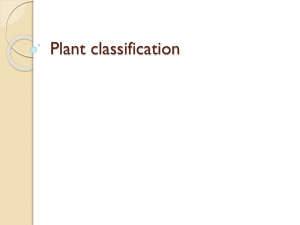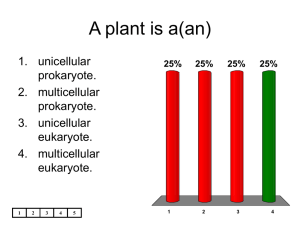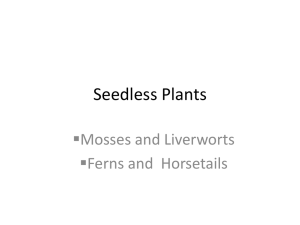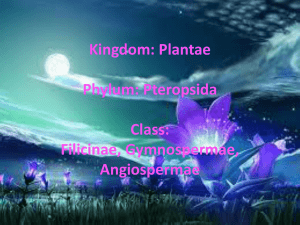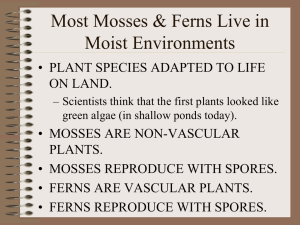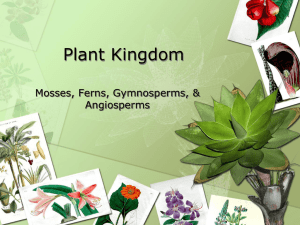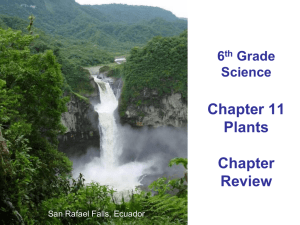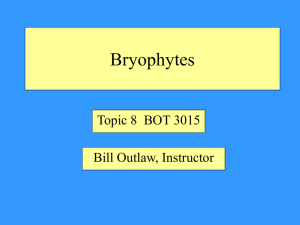seed plants nov 24
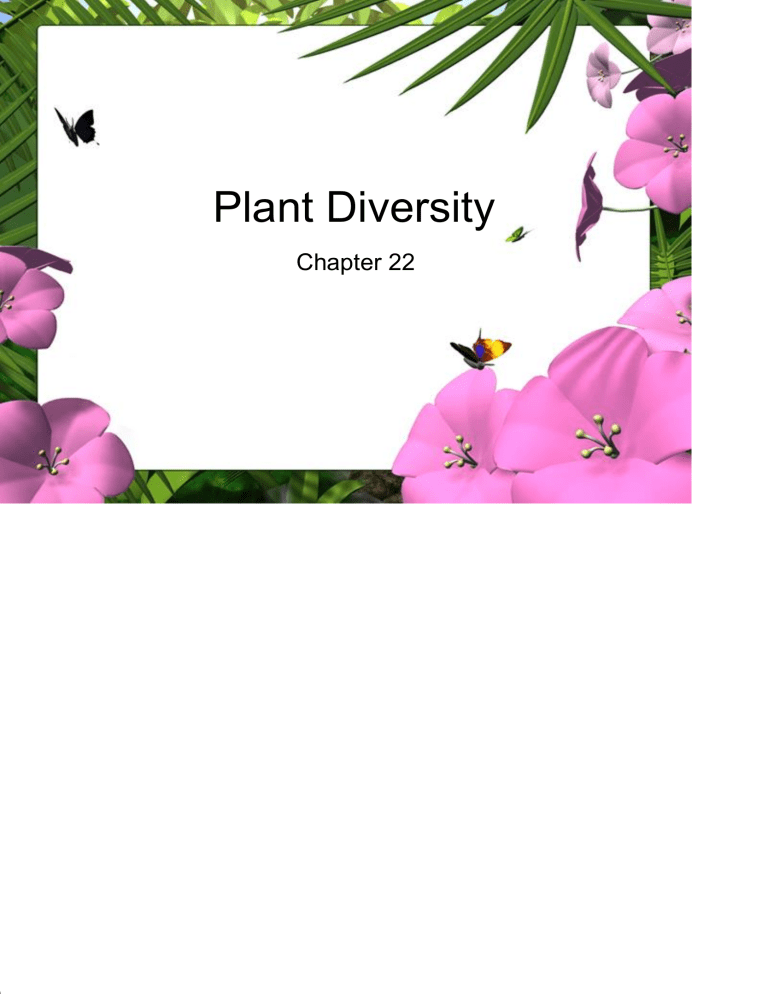
Plant Diversity
Chapter 22
22.1 Objectives
What Is a Plant?
What Is a Plant?
Plants are multicellular eukaryotes that have cell walls made of cellulose.
Plants develop from multicellular embryos and carry out photosynthesis using the green pigments chlorophyll a and b.
What Is a Plant?
Plants include trees, shrubs, and grasses, as well as other organisms, such as mosses and ferns.
Most plants are autotrophs, although a few are parasites or saprobes that live on decaying materials.
What Plants Need to Survive
What Plants Need to Survive
In order to survive, plants need: sunlight water and minerals gas exchange transport of water and nutrients throughout the plant body
What Plants Need to Survive
Sunlight
Plants use energy from sunlight to carry out photosynthesis.
Photosynthetic organs such as leaves are broad and flat to maximize light absorption.
What Plants Need to Survive
Water and Minerals
All cells require a constant supply of water.
Water is used up quickly when the sun is shining. As a result, plants have structures that limit water loss.
What Plants Need to Survive
As they absorb water, plants also absorb minerals.
Minerals are nutrients in the soil needed for plant growth.
What Plants Need to Survive
Gas Exchange
Plants require oxygen to support cellular respiration as well as carbon dioxide to carry out photosynthesis.
They must exchange these gases with the atmosphere without losing excessive amounts of water through evaporation.
What Plants Need to Survive
Movement of Water and Nutrients
Plants take up water and minerals through their roots, but they make food in their leaves.
Most plants have specialized tissues that carry water and nutrients from the soil and distribute products of photosynthesis throughout the plant body.
Simpler plants carry out these functions by diffusion.
Early Plants
How did the first plants evolve?
The First Plants
DNA sequences confirm that plants are closely related to certain groups of green algae, suggesting that the ancestors of the first plants were indeed algae.
Overview of the Plant Kingdom
Overview of the Plant Kingdom
Plants are divided into four groups and are
Seed-Less Plants
1. Mosses and their relatives
Non vascular
2. Ferns and their relatives
Vascular
Seed-Bearing Plants Vascular
3. Cone-bearing plants
4. Flowering plants
How are they Placed into the 4 Groups
They are placed into these groups according to these features: water-conducting tissues seeds flowers
Plants are also classified by other features, including reproductive structures and body plan.
Overview of the Plant Kingdom
Evolutionary Relationships Among Plants
Mosses and their relatives
Ferns and their relatives
Cone-bearing plants
Flowering plants
Flowers; Seeds enclosed in fruit
Seeds
Water-conducting (vascular) tissue
Green algae ancestor
Overview of the Plant Kingdom
Today, scientists can classify plants more precisely by comparing the DNA sequences of various species.
Learning Targets 22.2
Describe the adaptations of bryophytes (mosses and their relatives)
Identify the three groups of bryophytes
Bryophytes
( mosses and their relatives)
Mosses and their relatives are called bryophytes, or nonvascular plants.
They do not have vascular tissues, or specialized tissues that conduct water and nutrients.
Bryophytes
( mosses and their relatives)
Describe the adaptations of bryophytes
Bryophytes have life cycles that depend on water for reproduction.
Bryophytes draw up water by osmosis only a few centimeters above the ground.
Bryophytes are low-growing plants found in moist, shaded areas.
Bryophytes
( mosses and their relatives)
Identify the three groups of bryophytes
The three groups of bryophytes are: mosses liverworts hornworts
Bryophyte: Mosses
Mosses
The most common bryophytes are mosses.
Mosses: are adapted to life in wet habitats and nutrient-poor soils. can tolerate low temperatures.
are clumps of gametophytes growing together.
The Structure of a Moss
Each moss plant has a shoot that looks like a stem with leaves.
These are not true stems or leaves, because they do not contain vascular tissue.
Bryophyte: Mosses
The “leaves” of mosses are one cell thick, so they lose water quickly if the surrounding air is dry.
Mosses have rhizoids, which are long cells that anchor them in the ground and absorb water and minerals from the soil.
Water moves through rhizoids and into the rest of the plant.
Bryophyte: Mosses
Human Use of Mosses
Sphagnum mosses thrive in the acidic water of bogs.
Dried sphagnum acts as a natural sponge. It can accumulate to form peat deposits.
Peat can be cut from the ground and used as fuel.
Peat can be used to improve the soil’s ability to retain water and to increase soil acidity.
Sphagnum
Moss
Peat Moss
Bryophyte: Liverworts
Liverworts
Liverworts’ have broad, thin structures that draw up moisture from the soil surface.
Mature liverworts have structures that look like tiny green umbrellas.
These carry the structures that produce eggs and sperm.
Bryophyte: Hornworts
Hornworts
Hornworts are found only in soil that is damp nearly year-round.
They have structures that look like those of liverworts.
The hornwort has what looks like a tiny green horn.
Learning Targets 22.3
How is vascular tissue important to ferns and their relatives?
What are the characteristics of the three phyla of seedless vascular plants?
Evolution of Vascular Tissue
The first vascular plants were the first to have vascular tissue.
That is they had a new type of cell that was specialized to conduct water.
The first vascular plants contained tracheids which are cells specialized to conduct water.
Tracheids make up xylem, a transport subsystem that carries water from the roots to every part of a plant.
Evolution of Vascular Tissue
Evolution of Vascular Tissue
Vascular plants have a second transport subsystem composed of vascular tissue called phloem.
Phloem transports solutions of nutrients and carbohydrates produced by photosynthesis.
Evolution of Vascular Tissue
H ow is vascular tissue important to ferns and their relatives?
Evolution of Vascular Tissue
Evolution of Vascular Tissue
Together xylem and phloem move water, nutrients, and other materials throughout the plant.
In many plants, xylem and lignin (a substance that makes cell walls rigid) enable them to grow upright and tall.
Ferns and Their Relatives
W hat are the characteristics of the three phyla of seedless vascular plants?
Ferns and Their Relatives
Seedless vascular plants include: club mosses horsetails ferns
Ferns and Their Relatives
Ferns and Their Relatives
The most numerous phylum is the ferns.
Ferns and their relatives have true roots, leaves, and stems.
Do we need to review these?
Ferns and Their Relatives
Club Mosses
Ancient club mosses grew into trees and produced forests.
Fossilized remains of these exist today as huge beds of coal.
Today, club mosses are small plants that live in moist woodlands.
Ferns and Their Relatives
Horsetails
The only living genus of Arthrophyta is Equisetum.
Equisetum has true leaves, stems, and roots.
Equisetum is called horsetail, or scouring rush.
Ferns and Their Relatives
Ferns
Ferns probably evolved 350 million years ago, when club moss forests covered Earth.
Ferns thrive in wet areas with little light.
Life Cycle of Ferns
Ferns have vascular tissues, strong roots, underground stems called rhizomes , and leaves called fronds .
Life Cycle of Ferns
The Underside of a Fern Frond
Sporangia
Sorus
Learning Targets 22.4
What adaptations allow seed plants to reproduce without standing water?
What are the four groups of gymnosperms?
Seed-Bearing Plants
Seed plants are divided into two groups:
Gymnosperms bear seeds directly on the surfaces of cones.
Angiosperms, or flowering plants, bear seeds within a layer of tissue that protects the seed.
Seed-Bearing Plants
Gymnosperms include conifers, cycads, ginkgoes, and gnetophytes.
Angiosperms include grasses, flowering trees and shrubs, and all species of flowers.
Seed-Bearing Plants
Reproduction
Reproduction Free From Water
They do not need water for fertilization of gametes.
Seed plants can live just about anywhere.
Seed-Bearing Plants
Reproduction
Adaptations that allow seed plants to reproduce without water include: flowers or cones the transfer of sperm by pollination the protection of embryos in seeds
Seed-Bearing Plants
Reproduction
Cones and Flowers
Cones are the seed-bearing structures of gymnosperms,
Flowers are the seed-bearing structures of angiosperms.
Seed-Bearing Plants
Reproduction
Pollen
The male gametophyte is contained in a tiny structure called a pollen grain.
Sperm do not need water to fertilize eggs; instead the pollen grain is carried to the female reproductive structure by wind, insects, or small animals.
This transfer of pollen is called pollination.
Seed-Bearing Plants
Reproduction
Seeds
A seed is an embryo of a plant that is encased in a protective covering and surrounded by a food supply.
An embryo is an organism in its early stage of development.
The seed coat surrounds and protects the embryo and keeps contents of the seed from drying out.
When a seed grows, it uses nutrients from the stored food supply.
Seeds can survive extreme cold or heat, or even drought.
Seed-Bearing Plants
Reproduction
Seed-Bearing Plants
Reproduction
Seeds may have special tissues or structures that aid in their dispersal to other habitats.
Some seed coats stick to the fur or feathers of animals.
Other seeds are within tissues eaten and dispersed by animals.
Seed-Bearing Plants
Gymnosperms
Gymnosperms —Cone Bearers
The four groups of gymnosperms are: gnetophytes cycads ginkgoes conifers
Seed-Bearing Plants
Gnetophytes
Gnetophytes
About 70 present-day species of the phylum Gnetophyta are known, placed in just three genera.
In biology, a genus (plural: genera) is a taxonomic unit
Reproductive scales of these plants are clustered into cones.
Seed-Bearing Plants
Cycads
Cycads
Cycads are palmlike plants that reproduce with large cones.
Today, only nine genera of cycads exist.
They grow naturally in tropical and subtropical places.
Seed-Bearing Plants
Ginkgoes
Ginkgoes
Today the phylum Ginkgophyta contains only one species,
Ginkgo biloba.
Ginkgo trees are planted in U.S. cities because of their resistance to air pollution.
Seed-Bearing Plants
Conifers
Conifers
Conifers are the most common gymnosperms, with more than 500 known species.
Conifers include pines, spruces, firs, cedars, sequoias, redwoods, junipers, and yews.
Seed-Bearing Plants
Conifers Ecology
Ecology of Conifers
Conifer leaves have specific adaptations to dry conditions.
Most developed long, thin leaves, which reduce evaporation.
Their leaves have a thick, waxy layer.
Most conifers are “evergreens” and retain leaves all year.
22.5 Objectives
What are the characteristics of angiosperms?
What are monocots and dicots?
What are the three categories of plant life spans?
Seed-Bearing Plants
Angiosperms
The majority of living plant species are flowering plants, or angiosperms.
Seed-Bearing Plants
Angiosperms
What are the characteristics of angiosperms?
Seed-Bearing Plants
Angiosperms Reproduction
Angiosperms develop unique reproductive organs known as flowers.
Seed-Bearing Plants
Angiosperms Reproduction
Flowers have an advantage because they attract animals, which then transport pollen from flower to flower.
Flowers contain ovaries, which surround and protect the seeds.
After pollination, the ovary develops into a fruit.
A fruit is a wall of tissue that surrounds a seed. A fruit protects the seed and aids in its dispersal.
Seed-Bearing Plants
Angiosperms Diversity
Diversity of Angiosperms
Angiosperms are categorized in many ways: monocots and dicots woody and herbaceous plants annuals, biennials, and perennials
An angiosperm can belong to more than one category.
Seed-Bearing Plants
Angiosperms Diversity
Monocots and Dicots
There are two classes within the angiosperms —monocots and dicots
Seed-Bearing Plants
Angiosperms Diversity
Monocots and dicots are named for the number of seed leaves, or cotyledons, in the plant embryo.
Monocots have one seed leaf dicots have two
A cotyledon is the first leaf or the first pair of leaves produced by the embryo of a seed plant.
Seed-Bearing Plants
Angiosperms Diversity
Monocots include corn, wheat, lilies, orchids, and palms.
Dicots include roses, clover, tomatoes, oaks, and daisies.
Seed-Bearing Plants
Angiosperms Diversity
Woody and Herbaceous Plants
Flowering plants are also categorized by the woodiness of the stem.
Woody plants are made primarily of cells with thick cell walls that support the plant body.
Woody plants include trees, shrubs, and vines.
Seed-Bearing Plants
Angiosperms Diversity
Plant stems that are smooth and nonwoody are characteristic of herbaceous plants.
Herbaceous plants do not produce wood as they grow.
Herbaceous plants include dandelions, zinnias, and petunias.
Seed-Bearing Plants
Angiosperms Life Span
Plant life span is determined by genetic and environmental factors.
What are the three categories of plant life spans?
Seed-Bearing Plants
Angiosperms Life Span
Annuals, Biennials, and Perennials
There are three categories of plant life spans: annual, biennial, and perennial.
Seed-Bearing Plants
Angiosperms Life Span
Annuals are plants that complete a life cycle in one growing season.
Seed-Bearing Plants
Angiosperms Life Span
Biennials complete their life cycle in two years. In the first year, they germinate and grow roots, short stems, and sometimes leaves. In the second year, they grow new stems and leaves, produce flowers and seeds, and die.
Seed-Bearing Plants
Angiosperms Life Span
Perennials live for more than two years.
Learning Targets 24.1
What are the reproductive structures of gymnosperms and angiosperms?
How does pollination differ between angiosperms and gymnosperms?
Reproduction in Gymnosperms
What are the reproductive structures of gymnosperms
Reproduction in Gymnosperms
Reproduction in gymnosperms takes place in cones,
Gymnosperms produce two types of cones: pollen cones and seed cones.
Reproduction in Angiosperms
What are the reproductive structures of angiosperms?
Reproduction in Angiosperms
Structure of Flowers
Flowers are reproductive organs that are composed of four kinds of specialized leaves:
Sepals
Petals
Stamens carpels.
Structure of Flowers
Parts of a Typical Flower
Stamen
Anther
Filament
Ovary
Stigma
Style
Ovary
Carpel
Ovule
Sepal
Petal
Flower Structure and Function
Sepals enclose the bud before it opens and protect the flower while it is developing.
Petals are often brightly colored and are found just inside the sepals.
Petals attract insects and other pollinators to the flower.
The male parts of a flower consist of an anther and a filament, which together make up the stamen.
Flower Structure and Function
The filament is a long, thin stalk that supports an anther.
The innermost floral parts are carpels, also called pistils, which the female gametophytes
Each carpel has a broad base forming an ovary.
The ovary contains one or more ovules where female gametophytes are produced.
Flower Structure and Function
The narrow stalk of the carpel is the style
An anther is an oval sac where meiosis takes place, producing pollen grains
Reproduction in Angiosperms
Life Cycle of Angiosperms
Reproduction in angiosperms takes place within the flower.
Following pollination and fertilization, the seeds develop inside protective structures.
Pollination
Pollination
The cycle begins as male cones release pollen grains.
Pollen grains are carried by the wind and reach female cones.
Pollination Gymnosperms and Angiosperms
Pollination
Most gymnosperms and some angiosperms are wind pollinated, whereas most angiosperms are pollinated by animals.

